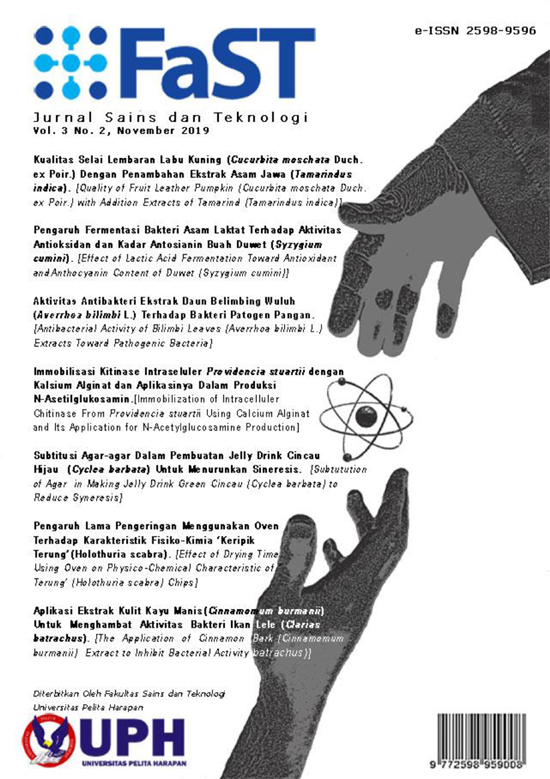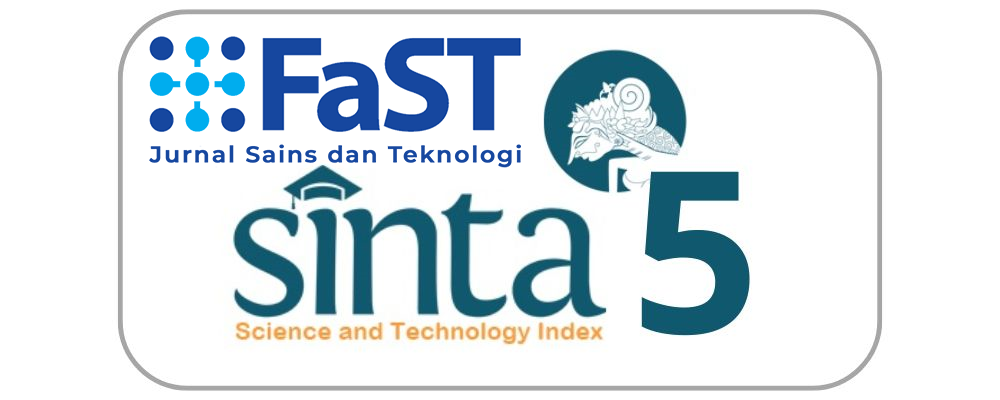PENGARUH FERMENTASI BAKTERI ASAM LAKTAT TERHADAP AKTIVITAS ANTIOKSIDAN DAN KADAR ANTOSIANIN BUAH DUWET (Syzygium cumini)
Keywords:
Duwet, Syzygium cumini, Fermentasi Asam Laktat, Aktivitas Antioksidan, Kandungan AntosianinAbstract
Bakteri Asam Laktat memiliki kemampuan untuk menguraikan senyawa fenolik yang berkorelasi terhadap aktivitas antioksidan dari buah dan sayuran. Penelitian ini bertujuan melihat pengaruh perubahan dari senyawa fitokimia dan aktivitas antioksidan dari buah duwet, yang difermentasi dengan beragam jenis bakteri asam laktat. Buah Duwet kaya akan antioksidan, terutama disebabkan oleh kandungan antosianinnya. Bakteri asam laktat yang digunakan didalam penelitian ini adalah Lactobacillus plantarum yang merupakan bakteri asam laktat heterofermentatif dan Lactobacillus acidophilus bakteri asam laktat yang bersifat homofermentatif dan bakteri asam laktat alami yang berasal dari proses fermentasi garam. Buah duwet yang sudah difermentasi kemudian di maserasi dengan menggunakan senyawa polar dan kemudian dianalisa kandungan fitokimia dan aktivitas antiosidannya selama 24 hari fermentasi. Dari hasil analisa terlihat jenis bakteri asam laktat dan lama periode fermentasi mempengaruhi perubahan kandungan fitokimia dan aktivitas antioksidan dari buah duwet. Aktivitas antioksidan tertinggi didapatkan dari buah duwet yang difermentasi oleh Lactobacillus plantarum dengan peningkatan aktivitas antioksidan 64.03% lebih tinggi setelah 17 hari fermentasi dan diikuti oleh peningkatan total fenolik, flavonoid dan antocyanin sebesar 101.11, 123.54, dan 56.34%.
References
AbuBakar, M. F., Mohamed, M., Rahmat, A., Fry, J. 2009. Phytochemicals and antioxidant activity of different parts of bambangan (Mangifera pajang) and tarap (Artocarpus odoratissimus). Food Chemistry (113) : 479-483 Ayyanar,M., Subash, S. P. 2012. Syzygium Cumini (L.) Skeels: A Review of Its Phytochemical Constituents And Traditional Uses. Asian Pacific Journal of Tropical Biomedicine (23) : 240-246 Bamforth, C. W. 2005. Food, Fermentation and Micro-organisms. UK London: Blackwell Publishing. Bathelmebs, L., Divies C., Cavin J. F. 2000. Knockout of The P-coumarate Decarboxylase Gene From Lactobacillus plantarum Reveals The Existence of Two Other Inducible Enzymatic Activities Involved in Phenollic Acid Metabolism. Journal Applied and Environmental Microbiology (67): 3368-3375 Chang, C., Yang, M., Wen, H., Chern, J. 2002. Estimation of Total Flavonoid Content in Propolis by Two Complementry Colorimetric Methods. Journal Food Drug Analysis (10) :178-182 Chen, R., Chen, W., Chen. H., Zhang, G. 2018. Comparative Evaluation of the Antioxidant Capacities, Organic Acids, and Volatiles of Papaya Juices Fermented by Lactobacillus acidophilus and Lactobacillus plantarum. Journal of Food Quality(18) : 23-35 Curiel, Jose A., Pinto, D., Marzani, B., Filannino, P., Farris, Giovanni A., Gobbetti, M., dan Carlo Giuseppe Rizzelo. 2015. Lactic acid fermentation as a tool to enhance the antioxidant properties of Myrtus communis berries. Journal Microbial cell wall. Vol.14 : 45-59 Giusti, M. M., Wrolstad, R. E., 2013. Characterization And Measurement Of Anthocyanins by UV-Visible Spectroscopy. Journal of Current Protocol in Food Analytical Chemistry : 1-13 Hunaefi, D., Akumo, D.N., Riedel, H., Smetanska, I. 2012. The Effect of Lactobacillus plantarum ATCC 8014 and Lactobacillus acidophilus NCFM Fermentation on Antioxidant Properties of Selected in Vitro Sprout Culture of Orthosiphon aristatus (Java Tea) as a Model Study”. Antioxidants (Basel) 1(1): 4-32 Ismail, M., Bagalkotkar G., Iqbal S., dan Adamu H. A. 2012. Anticancer Properties and Phenolic Contents of Sequentially Prepared Extracts from Different Parts of Selected Medicinal Plants Indigenous to Malaysia. Molecules (17): 5745-5756 Jien Jung., Hye, Jijang., Jie Eom Su., Soon Choi, Nam., Lee, Na Kyoung., Hyung, Dong Paik. 2019. Fermentation of red ginseng extract by the probiotic Lactobacillus plantarum KCCM 11613P: ginsenoside conversion and antioxidant effects”. Journal of Ginseng Research (43)1:20-26 James, C. S., 1995. Experimental Method on Analytical Chemistry of Foods. New York: Chapman and Hall Kong, J. M., Chia, L. S., Goh, N. K., Chia, T. F., Brouillard, R. 2013. Analysis and Biological Activities of Anthocyanins. Journal Phytochemistry (64) : 923-933 Latimer, G. W., dan Horwitz, W. 2007. Official Methods of Analysis of The Association of Official Analytical Chemist International 18th Edition. Washington DC: AOAC International. Leal-Sanchez, M.V., Ruiz-Barba, J. L., Sanchez, A. H., Rejano, L., Jimenez-Diaz, R., Garrido, A. 2003. Fermentation Profile and Optimization of Green Olive Fermentation Using Lactobacillus plantarum LPC10 As a Starter Culture. Journal Food Microbiology. (20):421-430 Mateus, N., Freitas V. 2009. Anthocyanins: Biosynthesis, Functions, and Applications. New York: Springer Science & Business Media Nishitani, Y., Osawa, R. 2003. Novel Colorimetric Method to Quantify Tannase Activity of Viable Bacteria. Journal of Microbiological Methods (54):281-284 Norfarizan-Hanoon, N. A., Asmah, R., Rokiah, M. Y., Fauziah, O., Faridah, H. 2009. Effect of Strobilanthes crispus Juice on Wound Healing and Antioxidant Enzyms in Normal and Streptozocin-induced Diabetic Rats”. Journal Biology Science(9):662-668 Rhee, S. J., Lee, J. E., Lee, C. H. 2011 Importance of Lactic Acid Bacteria in Asian Fermented Foods. Microbial Cell Factories (2):121-135 Rodriguez, H., Curiel, J. A., Landete, J. M., Rivas, B., Felipe, F. L., Cordoves, C. G., Mancheno, J. M., Munoz, R. 2009 Food Phenolics and Lactic Acid Bacteria. International Journal of Food Microbiology (132):79-90 Rohman, A., Riyanto S. 2005. Daya antioksidan ekstrak etanol daun kemuning (Murraya paniculata (L) Jack) secara in vitro. Majalah Farmasi Indonesia (16)3:136-140 Tian, S., Wang, J., Cheng, X. F. 2005, Ethanol Production of Immobilized Zymomonas mobilis [J]. Acta Energiae Solaris Sonica (26)2: 219-223 Wrolstad, R. E., Durst, R. W., Jugmin, L. 2005. Tracking Color and Pigment Changes in Anthocyanin Products” Trends in Food Science & Technology (16): 423-428 Zhang, D., Wuantick P. C., Grigor J. M. 2000. Changes in Phenolic Compounds in Litchi (Litchi chinensis Sonn.) Fruit During Postharvest Storage. Postharvest Biol. Technol(19):165-172
Downloads
Published
Issue
Section
License
“Authors who publish with this journal agree to the following terms:
1) Authors retain copyright and grant the journal right of first publication with the work simultaneously licensed under a Creative Commons Attribution License (CC-BY-SA 4.0) that allows others to share the work with an acknowledgement of the work's authorship and initial publication in this journal.
2) Authors are able to enter into separate, additional contractual arrangements for the non-exclusive distribution of the journal's published version of the work (e.g., post it to an institutional repository or publish it in a book), with an acknowledgement of its initial publication in this journal.
3) Authors are permitted and encouraged to post their work online (e.g., in institutional repositories or on their website). The final published PDF should be used and bibliographic details that credit the publication in this journal should be included.”



